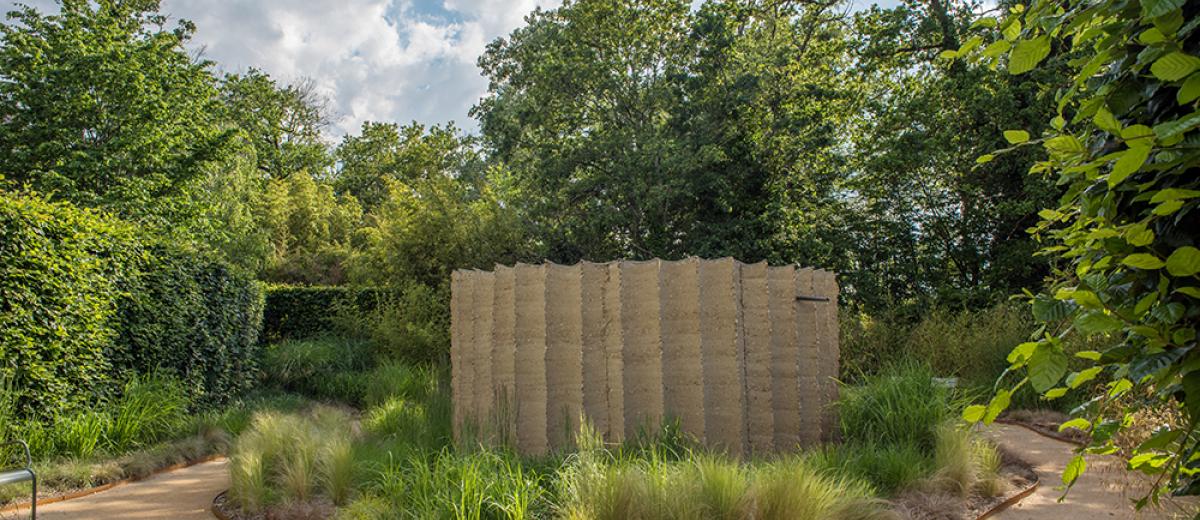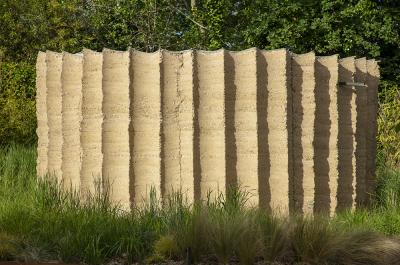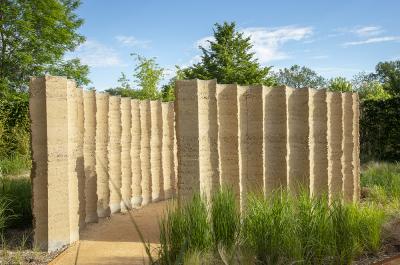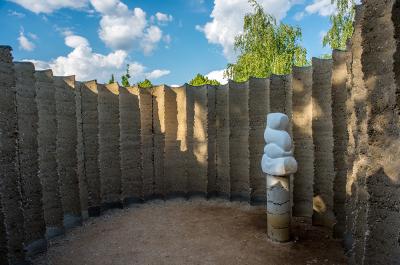17. Äng

When animals build their nests, they use the natural resources available to them. Ants in the forest collect pine needles, while ants in the desert dig tunnels in the sand. Mankind historically behaved in much the same way. In forest regions, wood was mainly used in construction, and in calcareous regions, masonry was preferred. Industrialisation eventually led to deflecting from local resources, and the traditional expertise of certain cultures is disappearing. To be able to use natural resources in a sustainable way, we have to figure out how to use the materials available to us in our immediate environment, and to recycle them. A place of rest and tranquillity, the “Äng” garden (“meadow” in Swedish) aims to create a place to reflect on this. A construction of rammed earth stands in a field of perennials, contrasting with the beauty of the garden plants. This open-air shelter provides protection from the outside world. Rammed earth creates layers of materials that resemble the geological strata of the Earth’s crust. The garden combines ornamental plants and edible cereals. The nature, composition and colours of the garden change through the seasons. The cereals germinate in the spring, flower in the summer and return to the earth at the end of the autumn. The rammed earth walls are also destined to disintegrate.
DESIGNERS

Aron Fidjeland is educated as an architect at the Royal Danish Academy of Fine Arts in Copenhagen, Universität der Künste Berlin and the KTH Royal Institute of Technology in Stockholm. Based in Stockholm he is working as a practising architect SAR, Swedish association of architects. Parallel with the work as an architect Aron has run a practice of his own working with scenography, exhibition architecture and art in the public realm. He has also been teaching and running workshops at Konstfack, University of Arts, Crafts and Design and KTH. He is currently working on the development of a theatre as well as working on private houses.
Vincent Dumay studied at the Paris-Est School of Town and Landscape Architecture as well as at the Faculty of Architecture, Design and Urban Planning at the University of Buenos Aires, from which he graduated in 2015. After professional experience in Paris and Buenos Aires, he moved to Stockholm, where he works with various architectural practices. He has worked on several collective housing projects, but has recently started specialising in heritage restoration. His work has led to an interest in the relationship between architecture and construction.
Baptiste Wullschleger is an architect who also has a post-graduate diploma in landscaping. He studied at the Paris Val de Seine School of Architecture and the Universität der Künste in Berlin. He gained his architecture diploma in 2012 and then worked for various practices in Vienna in Austria and Mumbai in India. He moved to Paris in 2015 and became a registered architect authorised to work independently (HMONP). He started working freelance and undertook flat renovation projects while working on submissions for architecture and design competitions. In 2018 he enrolled at the French School of Landscape Design in Versailles, working in the King's Kitchen Garden, and gained a postgraduate qualification in landscaping. Since 2018 he has been an associate of Les oiseaux architectures (LOA). This practice, which specialises in research and innovation, uses the observation of living things as a driver for creativity. LOA thinks that the human need to get back in contact with nature is just part of a greater desire to connect with others. In spatial terms, this is expressed through architecture that questions the human scale, and more philosophically its relationship with time, the timescale of trees.
Ella Rolf is a florist educated and based in Stockholm. Her aesthetical aim has been to rely on and focus on the explosivity of flowers instead of their delicacy. She is working as a floral concept designer in restaurants, but she is also using flowers as an artistic material. Her latest exhibition was called “To have and not to hold”, an experiment that eroticized the decomposition of flowers, juxtaposing beauty and death. At the moment she is investigating the possibilities of creating a space that is converging the performative traits of flowers rather than their decorative.


